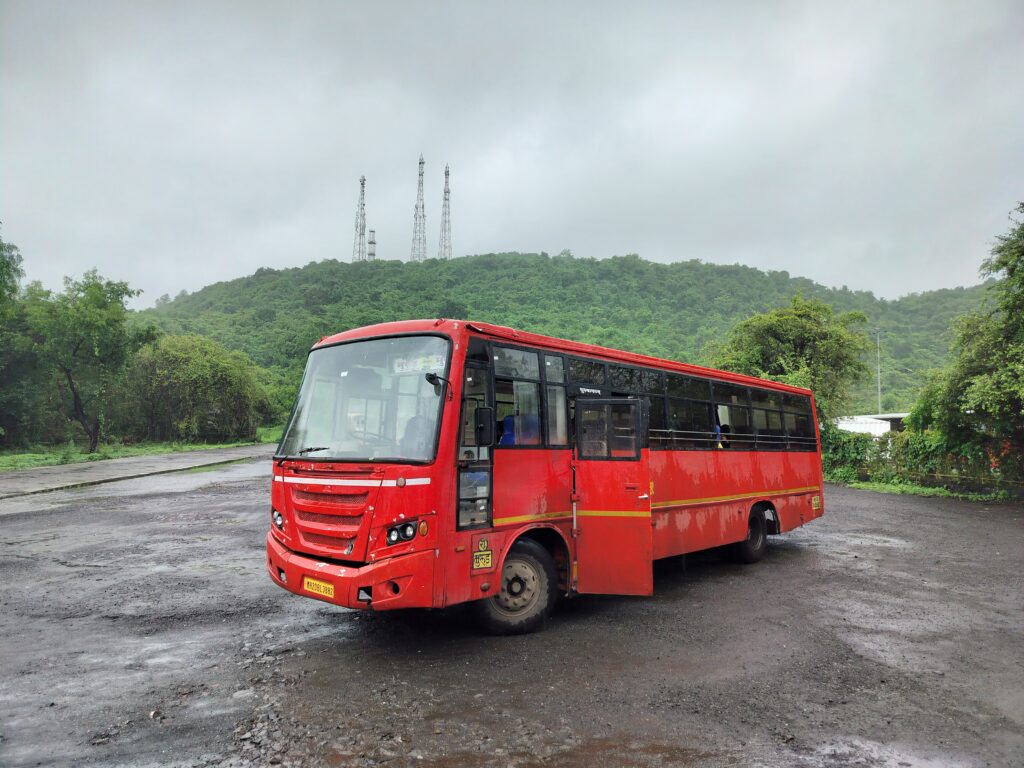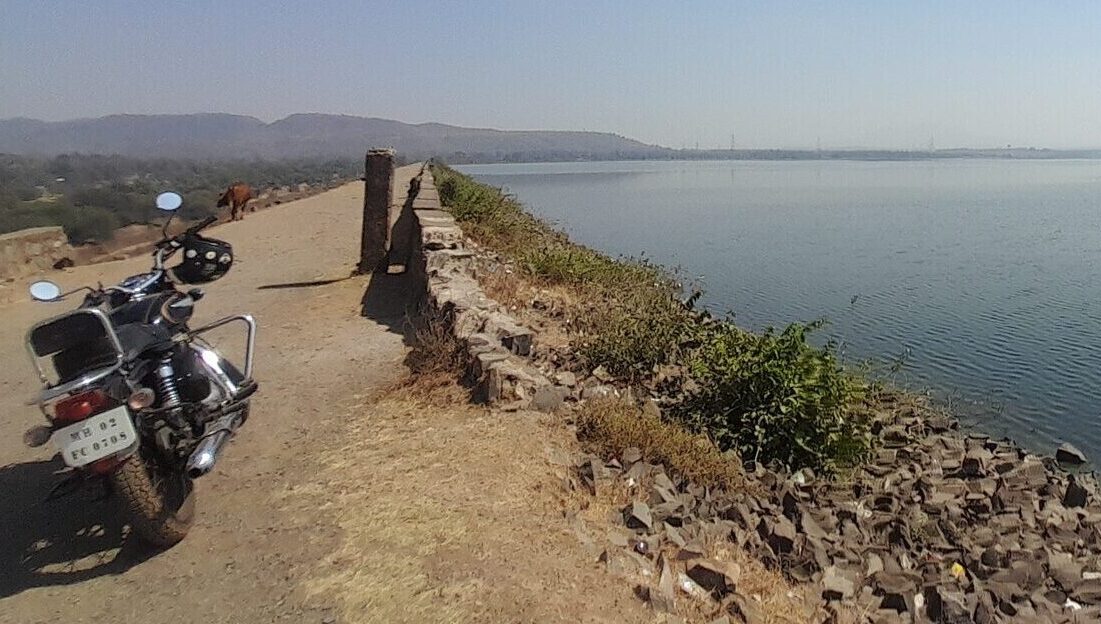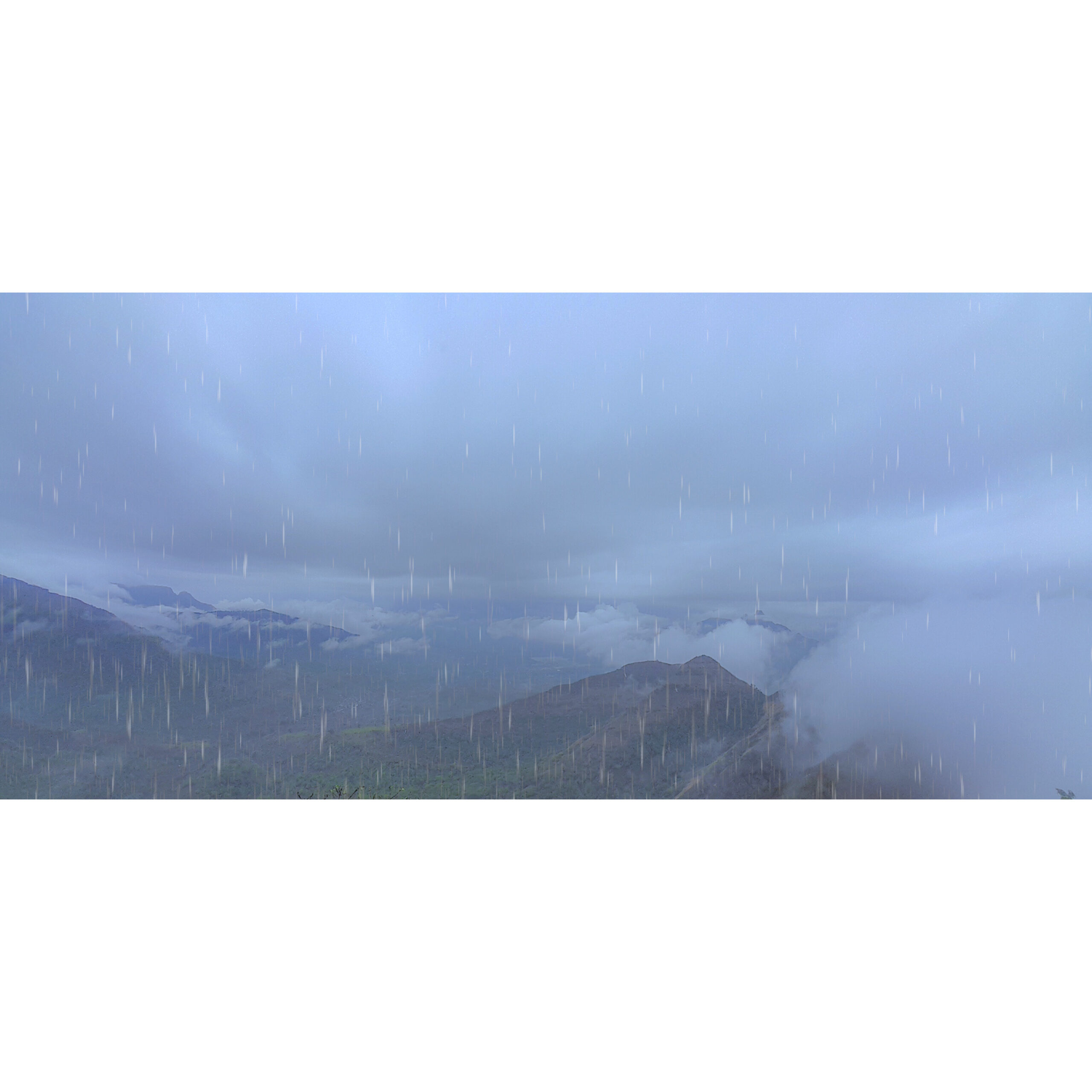Wanting to add some flavor to our platter of travel experiences, we decided to embark on a journey using a state transport (ST) bus. For the past four and a half years, we have thoroughly enjoyed our motorcycle road trips. Riding a bike offered us the freedom we desired—stopping at scenic locations, trying local cuisine at dhabas, taking detours to discover hidden gems, and encountering unexpected adventures. But would we experience the same freedom while traveling on a state transport bus?
Just two days before our planned trip, out of curiosity, we cancelled the motorcycle plan and booked tickets for the ST bus instead. We wanted to experience what it felt like to travel like locals without our own vehicle. We also booked a two-night stay on the outskirts of Murud and set off without any itinerary, in search of a new travel adventure.
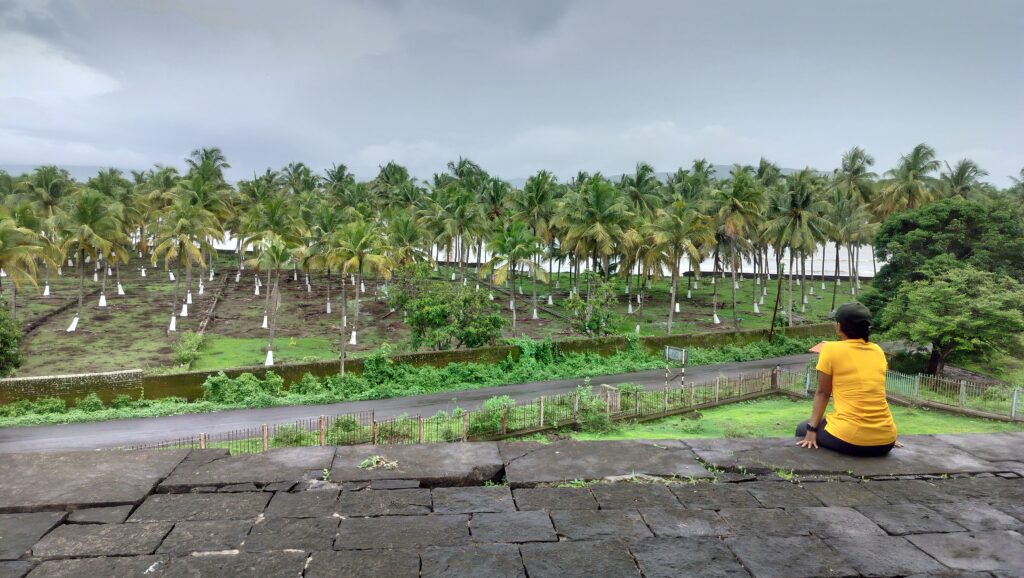
Across the picturesque landscapes of Maharashtra, one iconic symbol of public transportation stands out: the ‘ST Bus,’ operated by the Maharashtra State Road Transport Corporation (MSRTC). For an impressive 77 years, the ST, affectionately known as ‘Lal Pari,’ has become an integral part of the lives and memories of many. With its vibrant crimson exterior and distinctive design, the ST Bus is more than just a mode of transport; it represents a cherished tradition that connects people from all walks of life. From enthusiastic schoolchildren clutching their backpacks to wise elders sharing stories of days gone by, the ST Bus caters to a diverse array of passengers who rely on it for their daily commute. Maharashtra’s varied geography—from the soaring Western Ghats and charming hills to tranquil plateaus and the stunning 720-kilometer stretch of coastline—makes the journey on an ST Bus not just a travel necessity, but an adventure in itself.
We were filled with excitement for our trip, yet a sense of uncertainty lingered about how long the bus ride would take to reach the coastal town of ‘Murud’ in Raigad district. As frequent travelers, sticking to our budget was essential, a constant thought in our minds as we prepared for the journey. The bus, with its familiar rumble and gentle sway, lumbered down the street, and I couldn’t help but wonder, “How will we explore further once we arrive in Murud?” A mix of anticipation and anxiety surged within me, hoping that the adventure ahead would be as delightful as we envisioned, filled with new experiences and memorable moments.
There were only four passengers in the bus, including us. It initially seemed like the bus would remain empty, but surprisingly, at every stop—Kurla, Chembur, and Vashi—crowds rushed in. By the time we reached Panvel, the bus was fully packed. The journey took four hours, which was much longer than the time it would take by bike. Although the newer ST models have more comfortable seats compared to the old ones, that comfort doesn’t mean much if the travel time is extended. Were we already missing our motorcycle?
The gentle breeze felt refreshing on my face as the bus cruised onto the bustling Mumbai-Goa highway. We were filled with hope that it would pick up speed and help us make up for the time we had lost. However, our optimism faded as it came to another halt at Pen and Wadhkhal. More passengers squeezed in, filling the narrow aisle until it felt almost cramped. Thankfully, we had managed to secure a reservation.
Once we left Wadhkal junction, the bus took a scenic detour along the Alibag-Pen road, winding through lush greenery. Most of the people around us were daily commuters heading to Alibag, chatting about their day while we eagerly anticipated reaching our destination. Finally, the ST bus rolled into Alibag at 01:30 pm, and we were absolutely starving since we had skipped breakfast to catch the bus on time.
When the driver announced a 10-minute break, we seized the opportunity to stretch our legs and find relief. As many people got off the bus, so many got on it. Little did we know that two women had settled into our reserved seats, blissfully unaware of our arrival. We found ourselves in the awkward position of having to prove that those seats were, in fact, ours.
Murud was located 50 km from Alibag, and our bus journey took us through the charming villages of Chaul, Kashid, and Korlai. The sight of the temples, lush coconut trees, and the sparkling sea brought back fond memories of our Mumbai-Goa motorcycle road trip along the coastline in April 2022. As we approached Nandgaon, dark clouds gathered overhead, unleashing a heavy downpour that transformed the surroundings into a glistening tapestry of nature. Yet, as the rain subsided, the air filled with the refreshing scent of wet earth, and the sun began to peek through the clouds, creating a warm and inviting atmosphere. Excitement for the new place filled the air, yet nervousness engulfed us like looming dark clouds, reminding us that every adventure holds the promise of the unknown.
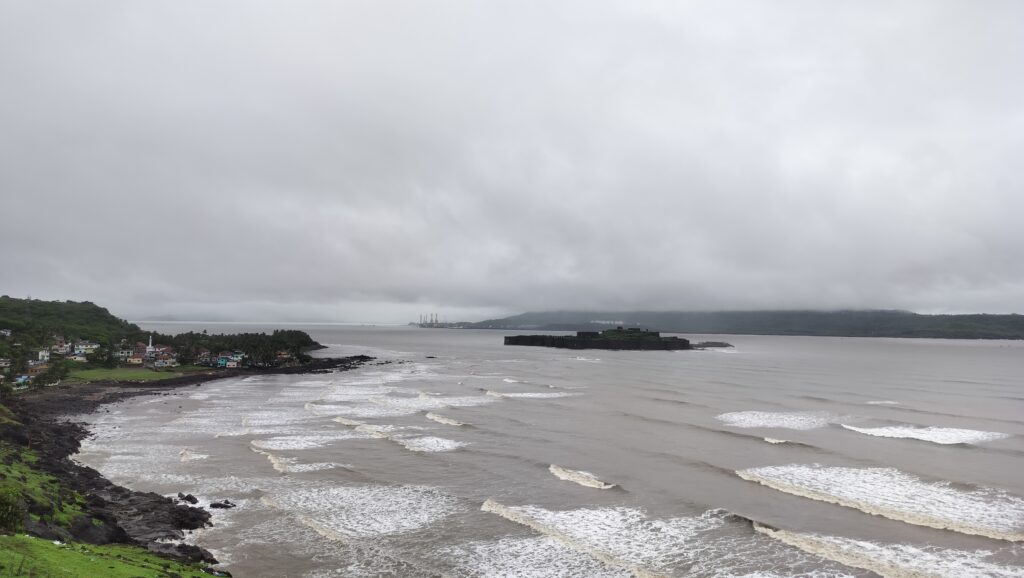
After a long seven-and-a-half-hour bus ride, we finally arrived in Murud at 3:30 PM. We had only traveled 150 kilometers, a distance we could have easily covered on a motorcycle in four to five hours with leisurely breaks along the way. However, sometimes you need to experiment in travel. Any mode of travel can lead to new experiences. As the bus was passing through Murud market, I noted that most shops were closed, their shutters down, leaving the streets quiet. My gaze fell on a small eatery that seemed to promise a taste of the local flavor. I desperately wanted to ask the driver to stop, but just as the thought formed, the bus picked up speed and dropped off the remaining passengers at the next stop.
New place. New faces. We were excited to make the most of our next two days. But at that point, we were so hungry that we couldn’t think of anything else. With hurried steps, we reached that eatery and quickly ordered two veg thalis, each plate brimming with an assortment of fragrant curries, fluffy rice, and warm, freshly cooked chapati. As we savored each bite, a wave of contentment washed over us, fueling our enthusiasm for the adventures that lay ahead.
“Swami Corner,” located opposite the Murud-Janjira Municipal School, became our go-to spot for delicious food over the next two days. We enjoyed our lunch there right after we got off the bus on Saturday. The following day, after our explorations, we ventured directly to the dhaba in the evening to indulge in “Kombadi Vade.” On our last day, after checking out of our resort and before boarding the bus to Mumbai, we again stopped by Swami Corner for breakfast, which included “Jhunka Bhakar” and “Usal Pav.”
This small dhaba is run by Mr. Mangesh Raghunath and is known for its home-cooked meals at budget-friendly prices. We found it to be the best eatery in the main market. Additionally, “Patil Khanaval,” located behind Samrat Guest House, is another popular eatery near the beachside that we recommend.
These little local explorations might have gone unnoticed had we chosen to travel by bike. If it hadn’t been for the bus that dropped us off at the market, we might never have discovered this dhaba. That’s why it’s so important to savor every moment of the journey, no matter how we choose to travel. While the bus ride was certainly a challenge, in these two days we learned to cope with the inconveniences. Our experience was not solely affected by the time consumed on the bus; we also encountered some issues at the resort we booked. The amenities and service didn’t quite align with what we had hoped for. While we faced disappointment when our expectations weren’t met, these two days of travel imparted invaluable lessons in patience and adaptability.
After finishing the meal, we discussed our travel plans. First, we needed to reach the resort, which was 7 kilometers away. Unfortunately, there were no shared autos or buses heading in that direction. Our only viable option was to book a private auto, which, sensing our urgency, might charge us an unreasonable fare because of our predicament. Being a quiet town, Murud lacked bike rental options unlike Alibag. There were, however, a couple of shops that rented old-school classic bicycles, which we kept as a backup if we couldn’t find anything else.
As we strolled through the empty streets of Murud, I spoke with several locals about motorcycle rentals. They provided a few phone numbers, but my calls didn’t yield any success. Determined to find a solution, one last time, I decided to check with Mr. Mangesh (owner of Swami Corner). To our pleasant surprise, he nodded and provided the mobile number of Gaurav Hanumante, the owner of Samrat Guest House at Murud Beach. We were one step closer to securing our ride.
The deal was finalized at last, and a sense of relief washed over us as we successfully booked a scooty unexpectedly. Gaurav, with a cheeky grin, handed over the key and quipped, “This is not my legal business. Ride safely.” With that, we gained the freedom to explore the open roads on our own terms. After enduring a long, cramped journey on the bus, the prospect of wind in our faces and the thrill of discovery filled us with a renewed sense of joy.
The clock indicated that it was 06:30 pm. The road went past the Murud fish market, where the dimming evening light was gradually transitioning into night. The vibrant atmosphere was palpable, even as only two women remained, skillfully showcasing their catch of the day—fresh lobsters and delicate dried shrimp laid out with care. The colorful fishing boats, each painted in shades of blue, red, and yellow, swayed gently in the water, tethered on either side of the Ekdara bridge. The bridge, known for its breathtaking sunset views, evoked a sense of nostalgia, and I faintly recalled crossing it during our coastal trip to Goa. The entire experience was a shade of sights, sounds, and emotions, weaving together the joy of exploration with the beauty of nature that surrounded us.
By the time we checked into the resort, it was already late. The location was remote, far from the market, so there was no point in venturing out again. The only highlight of the resort was the view of the Janjira hills from our room’s window. Eager for the night to pass, we quickly embraced into the lap of sleep.
The next morning, I drew back the curtains to reveal a dramatic scene; thick, billowing clouds hung low over the hills, heralding the arrival of rain. The air was fresh and alive, accompanied by the melodious call of a peacock resonating through the misty landscape. The delightful sound lifted our spirits, filling us with anticipation for the experiences that awaited us this rainy day.
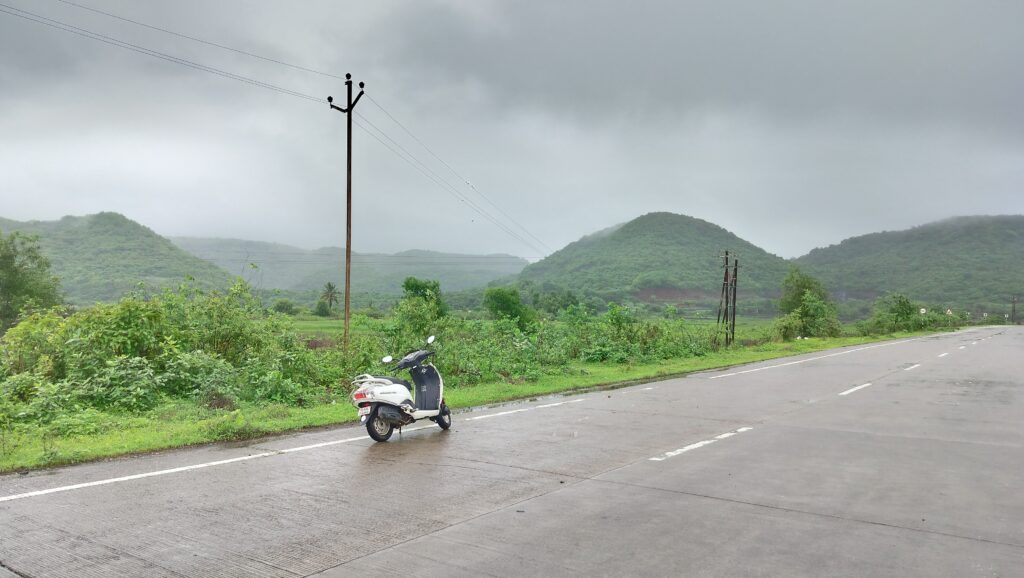
It was Sunday, and the town was still asleep. We were riding along the coastal road, taking in the view of the majestic sea fort of Janjira and the vast expanse of the Arabian Sea. Rain poured down heavily, and the roaring wind crashed the waves against the fort’s imposing structure. The aroma of rain mingled with the salty sea breeze, punctuated by the distinct scent of dried fish, which had absorbed the rainfall. With no itinerary to guide us, we surrendered to the lure of the road, trusting our instincts to lead the way. This decision allowed us to uncover the hidden treasures, each twist and curve offering a promise of new experiences, breathtaking views, and delightful surprises that awaited us around every bend.
Rajpuri is a lively village located along the coastline of Janjira Beach. It serves as a gateway to Janjira Fort, which remains closed during the monsoon season. The community includes both Hindus (Kolis) and Muslims, who live together in communal harmony. While riding through the area, I noticed a large Baobab tree that caught my attention. It is quite rare to encounter a Baobab tree near the coastline. The Siddis of Murud, with their roots tracing back to Africa, have a tradition of planting Baobab trees near their tombs and in various spots across Murud. These trees have been an integral part of the local landscape and cultural history. However, only a few, like this one, have managed to survive the harshness of an axe.
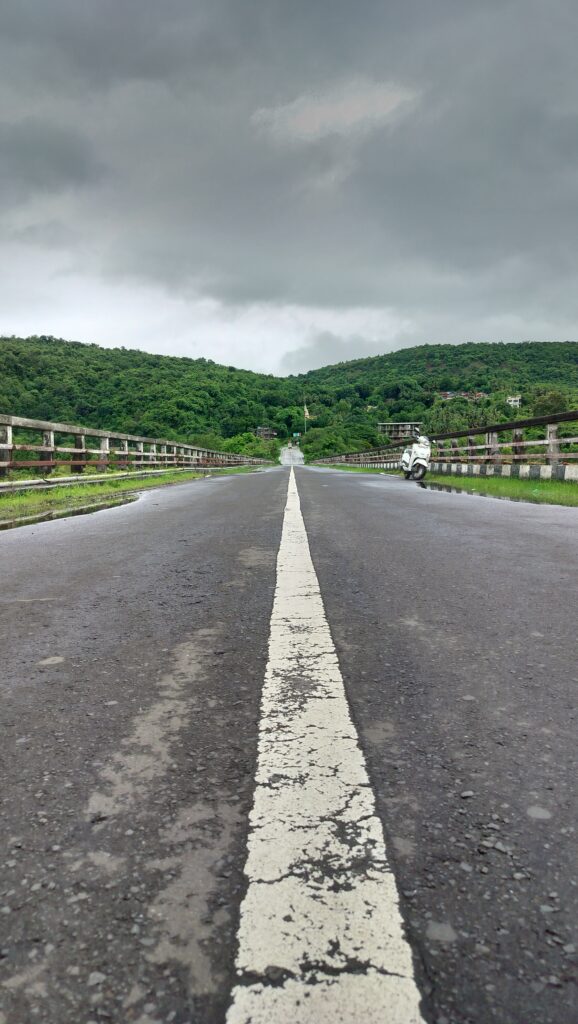
The ride was incredibly scenic, with lush green hills on one side and the vast expanse of the sea on the other. Setting out from the Agardanda jetty, we cruised along the winding Roha-Murud road. The Mandad bridge, standing gracefully over the Rajpuri creek, offered panoramic views that were perfect for capturing the moment in photographs. The Kundalika River meandered its way into the Arabian Sea, surrounded by tranquil wetlands. Guided by the signposts that beckoned us to explore, we took several detours, leading us to discover three unique gems near Murud-Janjira, each adding an unforgettable chapter to our adventure.
OUR EXPLORATIONS:
KUDA CAVES
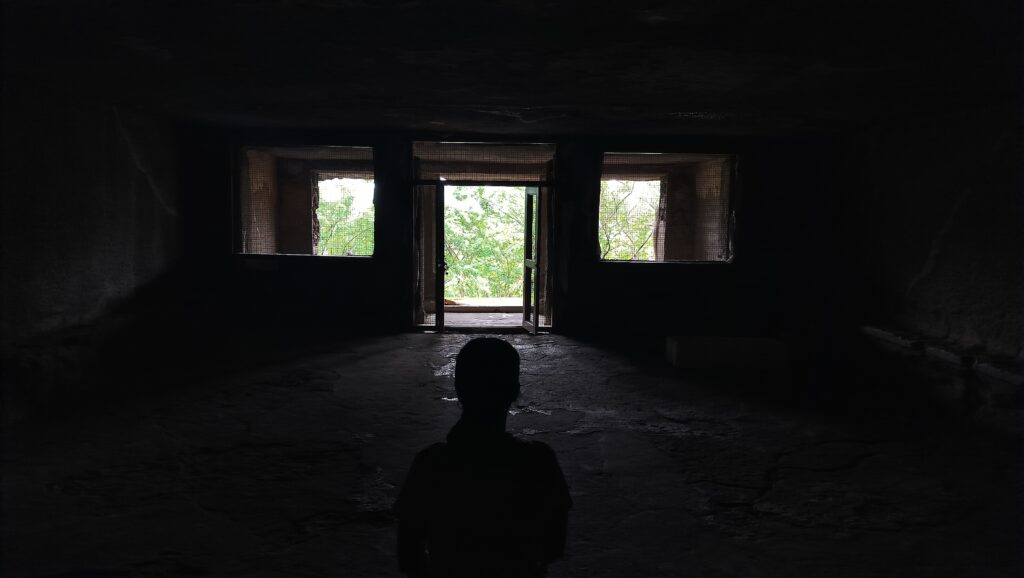
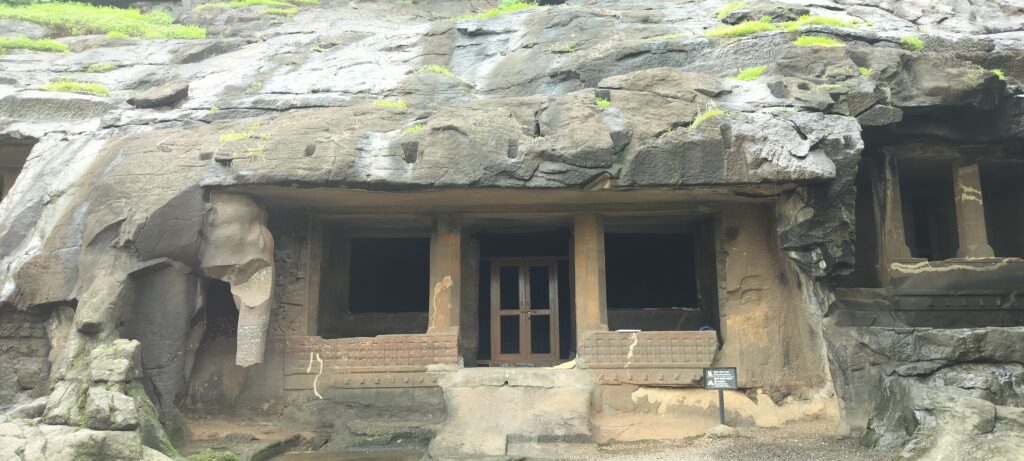
Kuda is a serene village located about 24 kilometers from Murud. This hidden gem has a breathtaking natural beauty, offering tranquility and a glimpse into an ancient past that dates back to the 3rd century CE. Here, you can find 26 intricately carved Buddhist caves that rest majestically on a hillside. Traveling to Kuda involves crossing the Mandad bridge, after which a straight diversion on the Tala-Murud road leads you through picturesque landscapes toward the village.
As we entered Kuda, we were instantly enveloped by its peaceful ambiance, free from the usual clamor of tourists. The caves, situated atop a hill, are gracefully encircled by lush greenery, adding to the enchanting atmosphere. A short, easy climb up recently constructed steps guides visitors to the caves, allowing them to experience the cool, fresh air and the gentle rustle of leaves surrounding them. We lost track of time as we spent more than an hour exploring the caves, feeling like we had stepped back in history. The only other souls present were the attentive security guards, who ensured the site remained undisturbed. In an effort to celebrate and promote these Buddhist heritage sites, the Maharashtra Tourism Development Corporation (MTDC) is planning to enhance tourist facilities at the Kuda caves.
The picturesque view of the Arabian sea significantly enhances the allure of the Kuda Caves. These caves are meticulously carved into two distinct levels: the lower level houses Caves 1 to 15, while the upper level consists of Caves 16 to 26. The caves include stupas, which were commonly used for worship in Buddhism. They also feature chaityagrihas (prayer halls), viharas, and eleven water cisterns thoughtfully designed to collect and store rainwater. Inscriptions on the walls and pillars provide information about donations made by Buddhist monks and members of the community.
Among the caves, Cave 6 stands out as the most elaborate and expansive. It is particularly remarkable for its intricate sculptures of elephants and a beautifully painted representation of the Buddha, both of which showcase the artistic skill and religious devotion of the time. Being there felt wonderful; the ancient carvings and sculptures captivated attention as we absorbed the silent glory of the past.
CHINCHGHAR DAM
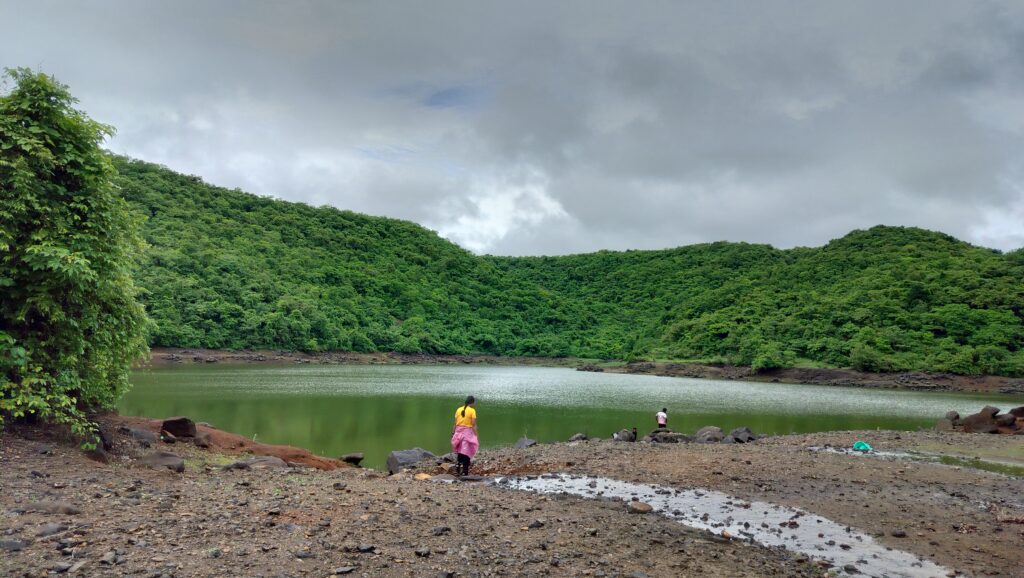
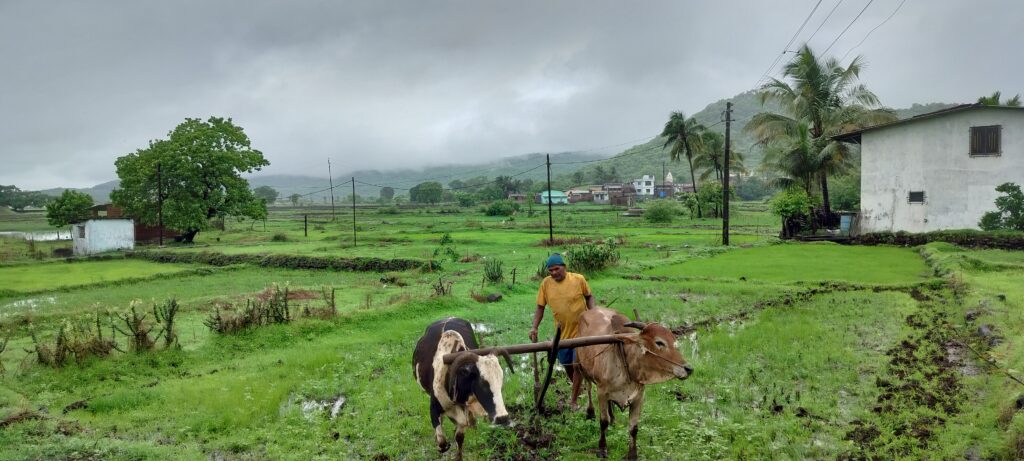
The ride from Murud was nothing short of breathtaking, with winding roads that led us through picturesque villages nestled against the backdrop of rolling hills and the glistening sea. One enticing detour looked captivating: a narrow road that seemed to snake its way into the hills, marked by a quaint signpost that read “Chinchghar.” Intrigued, we eagerly followed this path, flanked by vast, emerald fields stretching out on either side. Along the way, we came across a local villager diligently ploughing his rice fields with the help of sturdy bullocks. We seized the moment for a brief yet enriching conversation, capturing the essence of rural life in a few photographs before continuing our journey.
As we approached the dam, the mountains appeared to grow larger, adorned with a dense green blanket of foliage. To complete the picture-perfect scene, a waterfall cascaded down in the distance. From the village, we climbed for about fifteen minutes to reach the dam.
The water in the dam was calm, clear, and green. Sunlight danced off the verdant treetops, casting a shimmering reflection onto the surface, enhancing the green hue of the water. Local children were fishing while sitting on a large rock; they were surprised to see us and stared at us with curiosity.
Chinchghar may not be a well-known dam, but it reveals itself as a hidden gem—an oasis of tranquility surrounded by towering trees and vibrant birdlife, beckoning nature lovers to immerse themselves in its serene beauty and explore the unspoiled charm of the landscape.
KHOKARI TOMBS
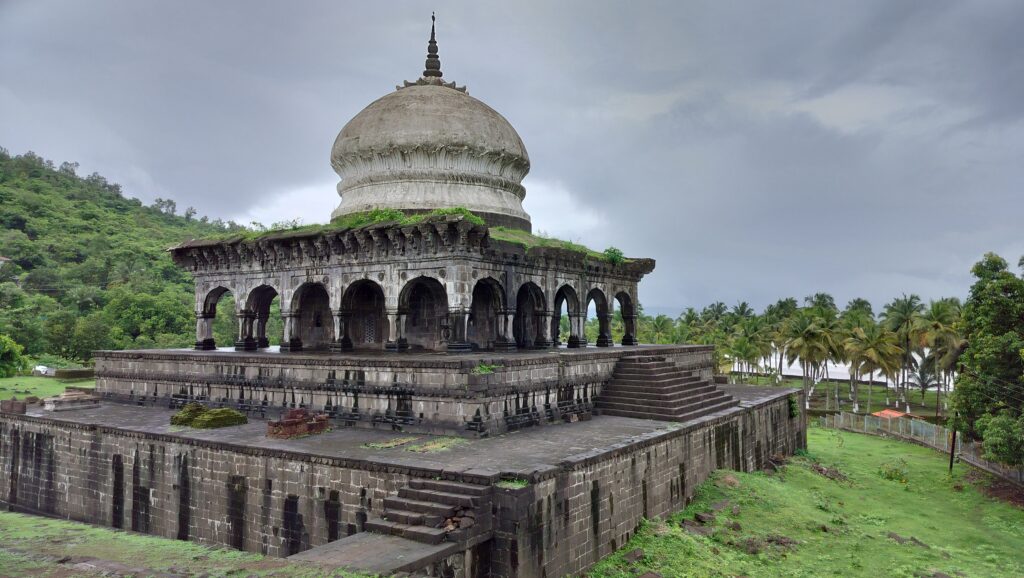
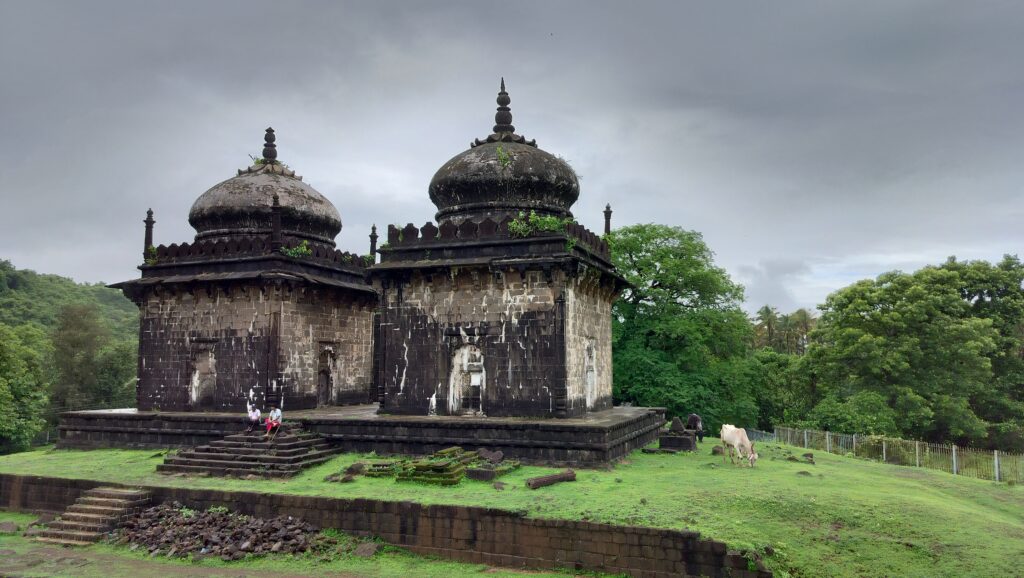
On the way to Rajapuri Creek, we encountered a striking complex of three massive stone structures that stand majestically against the backdrop of the sea. These impressive stone tombs, which are around 500 years old, serve as the final resting places for the rulers of Janjira. Today, this mausoleum is carefully preserved and protected by the Archaeological Survey of India, reflecting the rich history of the region.
During our last bike trip to Murud, we were unable to enter the monument site because the gates were closed. At that time, I wondered what could possibly be interesting about a tomb. Initially, I questioned the appeal of such structures, but I was amazed by the remarkable archaeological work I found within.
Built in the Indo-Saracenic architectural style, the complex features three prominent tombs, each showcasing exquisite craftsmanship. Scattered throughout the area, you will also find numerous smaller tombs dedicated to members of the Siddi nobility, adding to the complexity and historical significance of the site. The beautiful jali work on the windows, characterized by intricate patterns and designs, and the elegantly rounded arches of the doorways are stunning examples of timeless artistry. The finial crowning the dome adds a distinctive architectural flourish, enhancing the overall aesthetic.
We thoroughly enjoyed photographing this site. The breathtaking sea vistas, framed by coconut trees, appear untouched and seem frozen in time. The best time to visit is during the mid-afternoon to evening, when the sun bathes the area in a beautiful light. Watching the sunset from this vantage point provides stunning panoramic views of the Arabian Sea and the surrounding landscape, making it a truly memorable experience.
For those passionate about history and architecture, this site is an absolute must-visit, offering a unique glimpse into the past combined with natural beauty that captivates the soul.
FINAL THOUGHTS
A beautifully spent day uncovering the wonders of nature and history allowed us to forget the trials of our lengthy bus journey the day before. With the ST bus scheduled to take us back home the following day, we embraced the uncertainty of what to explore, and this day gifted us a treasure trove of unforgettable memories. Be it walking on the shore of Janjira beach or pausing on the mountain path, appreciating the stillness of the afternoon. After a tiring day, we loved walking along the shore, feeling the breeze and listening to the waves crash against the sand.
Each destination we visited offered a profound philosophical reflection. The mysterious caves of Kuda whisked us away on a journey through time, allowing us to connect with a past that felt almost tangible. Our peaceful walk among the trees at Chinchghar Dam beautifully anchored us in the present moment, reminding us of the simple joys that surround us. Finally, the majestic mausoleum at Khokari served as a poignant reminder of the uncertain future that awaits us all.
I found a sense of relief in not being behind the handlebars this time. The weight of responsibility that comes with riding can be quite overwhelming, and it was nice to simply enjoy the journey from a different perspective. Whether we will choose to travel by ST bus again in the future remains to be seen, but for now, we are content with this experience. Only time will reveal our next steps.
Until then, keep travelling, keep exploring!
